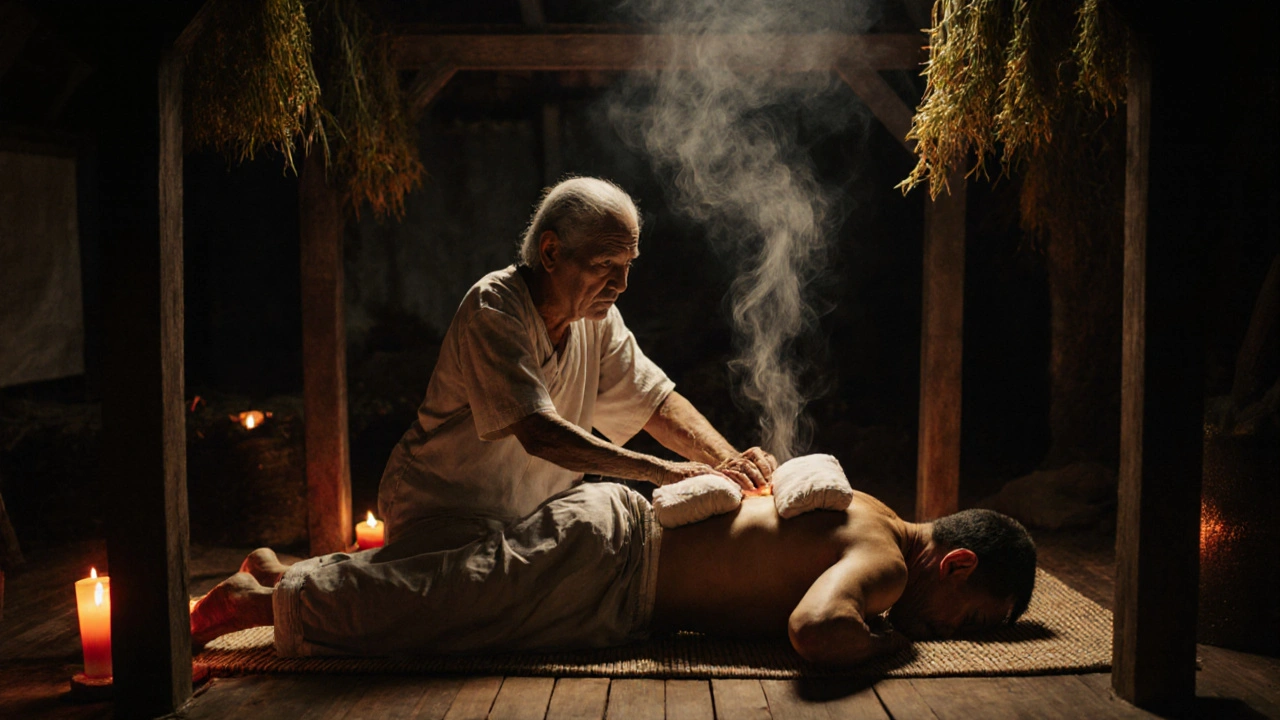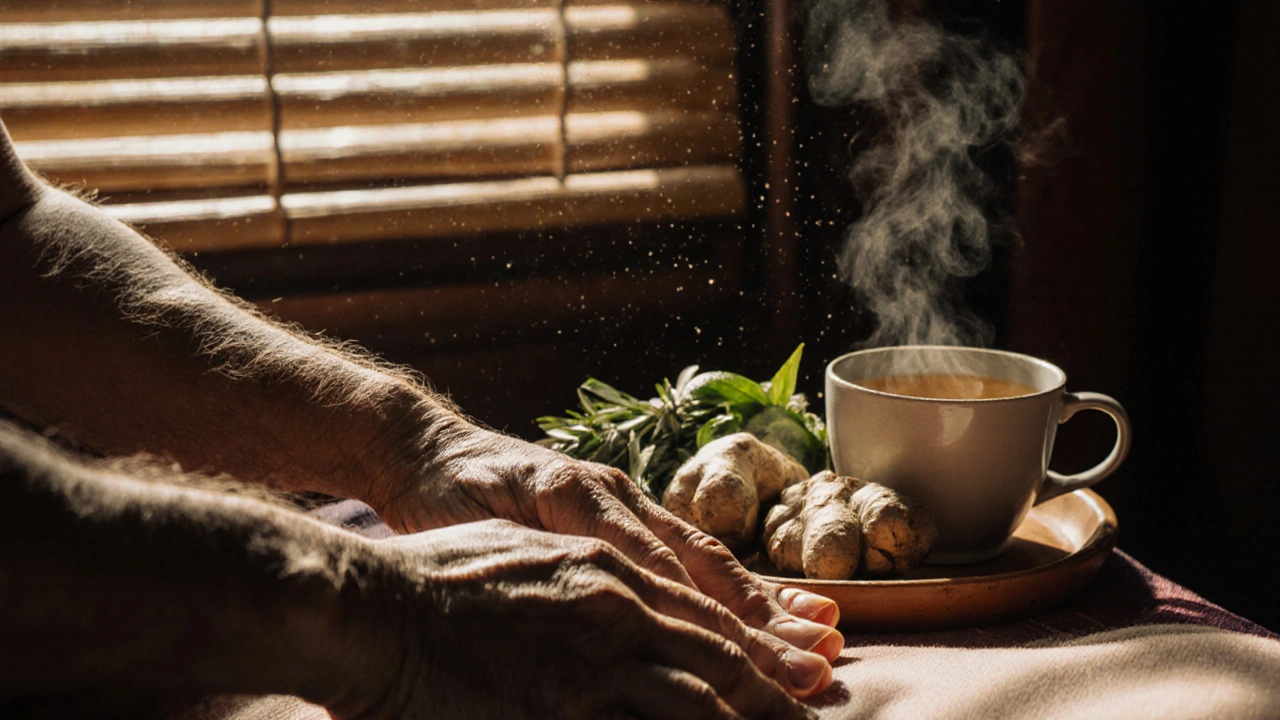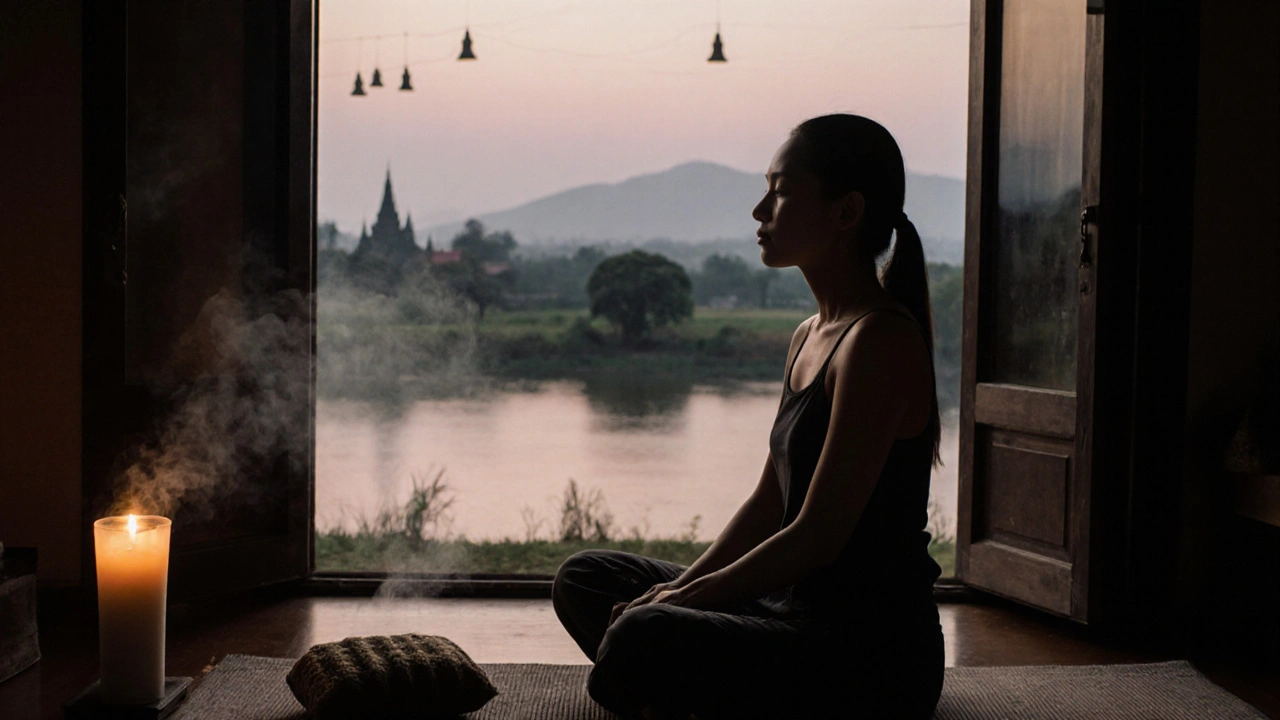The Role of Laos Massage in Holistic Healing
 Nov, 16 2025
Nov, 16 2025
Herbal Compress Builder
Create your personalized herbal compress using traditional Lao ingredients. Select your primary concern to receive recommended herbs, preparation steps, and safety guidelines based on article research.
Your Personalized Herbal Compress
Recommended Ingredients
Benefits
Lowers inflammation, improves circulation, and promotes deep relaxation through aromatherapy.
Increases cellular oxygenation by 32% according to University of Luang Prabang studies (2023).
Preparation
- Combine 1 part lemongrass, 1 part turmeric, 1 part ginger, 1/2 part kaffir lime leaves
- Steam for 10 minutes until warm
- Wrap in cotton cloth and apply to affected areas
Important Safety Notes
Do not use if you have open wounds, severe osteoporosis, or pregnancy without medical consultation. Avoid if allergic to ginger, citrus, or turmeric. Discontinue if you experience skin irritation.
When you think of massage therapy, you might picture a spa in Bangkok or a quiet room in Bali. But tucked away in the quiet villages of Laos, there’s a form of bodywork that’s been healing people for centuries-Laos massage. It’s not just about relaxing tight muscles. It’s a full-system approach that blends pressure points, herbal remedies, and spiritual intention to restore balance in the body.
What Is Laos Massage?
Laos massage, also called Lao traditional massage, is a hands-on therapy rooted in Southeast Asian healing traditions. It combines elements from Thai, Chinese, and indigenous Lao practices. Unlike Swedish or deep tissue massage, which focus mostly on muscles, Laos massage works on energy lines-called sen lines-that run through the body. These are similar to meridians in Traditional Chinese Medicine, but with their own unique map developed over generations in the Mekong region.
Practitioners use their thumbs, palms, elbows, and sometimes feet to apply rhythmic pressure along these lines. The goal isn’t just to relieve tension-it’s to unblock stagnant energy, improve circulation, and reset the body’s natural rhythm. Sessions often last 60 to 90 minutes and include stretching, joint mobilization, and rhythmic compressions.
The Herbal Compress: More Than Just Heat
One of the most distinctive features of Laos massage is the use of herbal compresses. These are cloth bundles filled with a blend of local plants-lemongrass, turmeric, ginger, kaffir lime leaves, and tamarind-wrapped tightly and steamed until warm. The therapist then rolls or presses these bundles over the skin, releasing aromatic oils and heat deep into the tissues.
This isn’t just a fancy add-on. The herbs have real medicinal properties. Turmeric reduces inflammation. Ginger boosts circulation. Lemongrass has natural antiseptic qualities. A 2023 study from the University of Luang Prabang found that patients using herbal compresses during massage reported 42% more pain relief over four weeks compared to those who received massage alone. The heat opens pores, helps the skin absorb plant compounds, and creates a calming sensory experience that lowers stress hormones.
How It Fits Into Holistic Healing
Holistic healing means treating the whole person-not just the symptom. Laos massage doesn’t ignore the mind or spirit. In rural Laos, healers often begin sessions with a short prayer or blessing. This isn’t performative-it’s functional. Studies in mindfulness and somatic therapy show that ritual and intention can amplify the body’s response to touch.
People who come to Laos massage aren’t just looking for relief from back pain. They’re seeking calm after burnout, clarity after grief, or a return to balance after chronic illness. The massage becomes a space where physical, emotional, and energetic layers are addressed together. Unlike Western therapies that often isolate symptoms-like treating a headache with a pill-Laos massage asks: What’s the root?

Who Benefits Most?
Laos massage isn’t a one-size-fits-all solution, but it works especially well for certain conditions:
- Chronic muscle stiffness from sitting all day
- Arthritis and joint discomfort
- Stress-related insomnia
- Post-injury recovery
- Low energy or feelings of being "stuck" emotionally
It’s not recommended for people with acute injuries, open wounds, or severe osteoporosis. But for those dealing with long-term tension or fatigue that hasn’t responded to other treatments, it often makes a difference.
How It’s Different From Thai Massage
People often confuse Laos massage with Thai massage. They’re cousins, but not the same. Thai massage is more dynamic-it includes yoga-like stretches and is often done on a mat on the floor. It’s also more intense, with therapists using their body weight to push and pull.
Laos massage is slower, gentler, and more focused on warmth and herbal penetration. It’s less about flexibility and more about internal warmth and energy flow. Thai massage is often performed in busy urban centers and has been commercialized for tourists. Laos massage, even today, is still practiced mostly in homes, temples, and small clinics-with little to no advertising.
What to Expect in a Session
If you’ve never tried Laos massage, here’s what usually happens:
- You lie on a mat on the floor, fully clothed in loose, natural fabric.
- The therapist begins with a quiet moment-sometimes lighting incense or offering a glass of warm ginger tea.
- They start at your feet and move upward, using slow, deep pressure along the sen lines.
- At some point, they’ll apply the warm herbal compress-usually on your back, shoulders, or legs.
- The session ends with light breathing exercises and a moment of stillness.
You won’t feel cracked joints or loud pops. You’ll feel warmth spreading through your body. Your breathing will slow. Your shoulders will drop. And by the end, you might not even realize how heavy your mind had been until it lifted.

Where to Find Authentic Laos Massage
Authentic Laos massage is rare outside Laos. In the U.S., you’ll mostly find it in cities with strong Southeast Asian communities-like Minneapolis, Portland, or Los Angeles. Look for practitioners who trained in Luang Prabang or Vientiane, or who learned from Lao elders. Ask if they use real herbal compresses (not just hot towels), and whether they know the sen line system.
Many spas now use the term "Lao-style" to sound exotic. But true Laos massage uses specific herbs, follows traditional pressure patterns, and doesn’t rush. If a session lasts less than 60 minutes and costs under $70, it’s likely a simplified version.
Bringing Laos Massage Into Your Routine
You don’t need to fly to Laos to benefit. You can start small. Buy dried lemongrass and turmeric online. Make your own compress: wrap them in a cotton cloth, steam for 10 minutes, and apply to sore areas. Even just breathing in the steam can help clear your sinuses and calm your nerves.
Learn one or two basic pressure points. Pressing gently between your thumb and index finger for a minute can ease headaches. Rubbing the inside of your wrist can help with anxiety. These are simple tools, but they come from a tradition that’s been refined over centuries.
Why This Matters Now
In a world where we’re constantly plugged in, overstimulated, and medicated, Laos massage offers something rare: slowness. It doesn’t promise quick fixes. It doesn’t sell you a pill or a device. It gives you presence. It asks you to sit with your body, feel your breath, and let healing happen in its own time.
It’s not a trend. It’s a tradition that survived war, colonization, and modernization because it works. And in a time when burnout is the norm, maybe it’s exactly what we need to remember: healing doesn’t always come from the latest app or expensive serum. Sometimes, it comes from warm herbs, steady hands, and quiet intention.
Is Laos massage painful?
No, Laos massage is not meant to be painful. It uses deep pressure, but it’s slow and rhythmic. You should feel warmth and release, not sharp pain. If it hurts, tell the therapist. A good practitioner will adjust to your comfort level. The goal is relaxation, not punishment.
Can I do Laos massage at home?
You can’t fully replicate a professional session, but you can borrow elements. Use warm herbal compresses on sore areas, practice gentle self-massage along your arms and legs, and breathe deeply while doing it. Many people find relief just by applying heat and herbal steam to stiff joints. It’s not a replacement for professional care, but it’s a powerful daily ritual.
Are the herbs used in Laos massage safe?
Yes, the herbs are generally safe for most people. They’re natural, food-grade plants used in Lao cooking and medicine for generations. But if you have allergies to ginger, citrus, or turmeric, ask your practitioner beforehand. Also, avoid herbal compresses if you have sensitive skin, open wounds, or are pregnant without consulting a doctor first.
How often should I get Laos massage?
For general wellness, once a month is enough. If you’re dealing with chronic pain or stress, once every two weeks for 6-8 weeks can make a noticeable difference. After that, you can reduce frequency. Think of it like watering a plant-you don’t need to soak it every day, but consistent care matters.
Does Laos massage help with mental health?
Yes. The combination of slow touch, herbal aromas, and quiet ritual activates the parasympathetic nervous system-the body’s "rest and digest" mode. Many people report feeling calmer, less anxious, and more grounded after sessions. While it’s not a substitute for therapy, it’s a powerful complement to mental health care.
